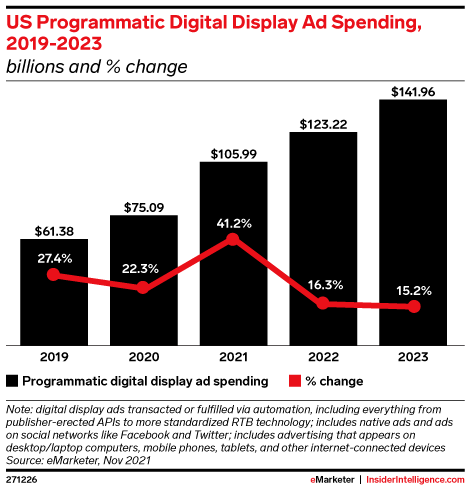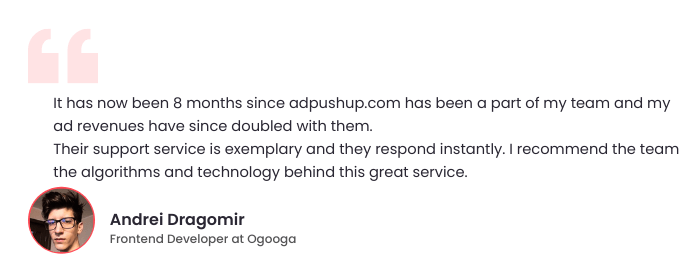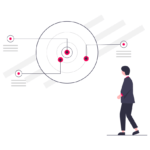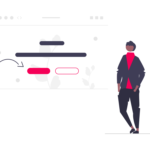Do you know North America accounted for nearly three-quarters of the global programmatic spending, and programmatic ad spending in the United States stood at 167 billion U.S. dollars in 2021? On the global level, the expenditure is set to reach 418 billion U.S. dollars by 2026.
In the United States, publishers and marketers ramp up investments in programmatic ads and spend more of their ad budgets on programmatic advertising.

While the adoption of programmatic digital ads is high in the United States, most publishers in Southeast Asia are still failing to implement the idea in practice.
Many across Asia still consider that programmatic only deals with a small inventory, which is simply not the case. This is a valuable service, especially to fully maximise video ad yield and ad revenue.
Also Read: A Guide to Programmatic Buying
So, what’s stopping publishers from fully embracing programmatic advertising? Well, here’s a guide to give you a little idea of the potential issues.
What Are the Top Programmatic Advertising Challenges?
Changes in Cookie Policies
The changes in cookie policies are the main challenge for programmatic advertisers exclusively for third-party cookies. Google Chrome has rolled out the update to stop supporting third-party cookies in 2023.
Other browsers like Safari and Firefox have already blocked third-party cookies. So, these changes will significantly impact programmatic advertising.
Not Focusing on Ad Fraud
Ad fraud is also among the main concern for programmatic advertisers, as the digital ad metrics revolve around impressions and views. Advertisers need to be sure that these views, clicks, etc., come from a valid source, not some bots or malicious forms.

Monitoring Programmatic Inventory
Programmatic inventory is essential as it refers to the ad inventory that a publisher makes available to purchase on the open market programmatically. This inventory is available for bidding in real-time and serves the ad in front of the viewer. This inventory is displayed across everyone’s browsers all over the world.
However, programmatic advertising allows the brands to serve their ads in front of relevant consumers, but advertisers are concerned with how to get the best quality.
The lack of knowledge is also a challenge in the ad tech industry. There’s always confusion with a new release of technology and platforms.
Each platform will have its features, and publishers must learn each. Also, there are different types of programmatic ad buying, and there’s a chance that agencies will recommend you a platform with a different approach. However, to make an informed decision, you must understand the solution to each challenge and how programmatic advertising could work for your brand.
Also Read: Programmatic Advertising Trends for Publishers in 2022
How Programmatic Ads Are Opening New Opportunities for Publishers?
Programmatic ads are the complete solution for automated buying and selling of online advertising between brands and agencies. The brands use a demand-side platform, or DSP, to buy the impressions and decide how much they should pay for each impression. The suppliers use a supply-side platform, or SSP, where they can sell these impressions to brands and agencies.
Some publishers prefer an Insertion order (IO) driven ad sales model; they find programmatic ads hard to swallow. But this is not true; the programmatic approach makes it far easier for publishers to maximize opportunities.
Programmatic Advertising has a lot to offer publishers, including:
- An easier platform to sell advertising space.
- Better collaboration between advertiser and publisher.
- Search relevance according to the demographic and user preferences.
- Reliable and efficient sales and ad placement opportunities and higher ROI for publishers.
There are a few more aspects of programmatic advertising that make this mechanism absolutely essential for publishers.
Programmatic Direct For Publishers
The benefits of programmatic advertising are not only about increased efficiency and flexibility. The Programmatic mechanism allows an advertiser to buy any inventory available on any publisher property. It is also helpful for an advertiser trying to reach specific users from a particular location or demographic.
Programmatic direct is the best approach in which direct deals are done between sellers and buyers without any mediator. This model relies on the direct connection between advertiser and publisher through an ad-buying system.
There are two types of Programmatic direct deals:
- Preferred Deals: It is direct trading where the volume of inventory is not fixed and the price is specified.
- Programmatic Guaranteed: It is also a direct form of trading where the price is specified and the volumes are guaranteed.
Through the direct programmatic model, deals can be more innovative and faster through private auctions, preferred modes, and guaranteed & non-guaranteed deals. This mechanism is helpful for both publishers and advertisers as it includes a set delivery timeline, a fixed number of impressions, and a preset price. It is a less time-consuming process.
Programmatic DOOH Campaigns

Programmatic is the automated buying and selling of ads based on data-driven decisions. However, Programmatic Digital OOH provides access to the large format digital screens for your existing programmatic campaigns. US DOOH spending is expected to cross $2.58 billion in 2022.
The concept of programmatic DOOH ads is beneficial for ad blockers and should be a significant part of the cookieless future because of its audience targeting and contextual marketing. Using this technology, brands can get data from societal, cultural, and environmental trends in real-time, so it will also be helpful to reach consumers with relevant ads.
The programmatic DOOH is an opportunity to create meaningful and marked impressions on consumers. There is no doubt that this concept is emerging as a disruptor to brands and marketers looking to develop their online presence during uncertain times.
Beyond that, programmatic audio offers remarkable granular targeting capabilities. Media buyers can tap into various advanced audience segmentation parameters, including location, point of interest, device, weather, user, agent, format, genre, day parting, mood, and more. Through this channel, the ability to engage a user in the right place, at the right time, and within the right context becomes just that bit more accessible.
With elevated reporting opportunities, publishers can better evaluate the deals they’re making, the ad procurement practices in use, and the outcomes of each campaign. It can inform future decision-making, empowering publishers to pursue the best possible deals, regardless of the marketplace.
Removal of Third-Party Cookies
The removal of third-party cookies from Chrome is the main challenge for publishers. However, this change will not impact Programmatic advertising, as even in the absence of persistent IDs, the programmatic concept will continue to give advertisers access to publishers with contextual targeting.
It is a massive opportunity for brands to reach their targeted consumers using emotion-driven engagement rather than relying on past behaviour or browsing habits. By using contextual data in programmatic campaigns, brands can improve engagement, brand loyalty, and brand advocacy.
Real-Time Bidding
Real-time bidding uses real-time buying and selling of ad impressions through auctions. This approach guarantees on-demand placement of ads in front of the right audience at the right time.
Before this model, it was very challenging for publishers to manage and improve their ad fill rates due to the complications related to ad placement.
However, Real-time bidding has solved this and ensured that ad placement could happen in a reliable and fast manner in the blink of an eye. It also results in more significant ROIs and higher CPM rates.
Final Words
To summarize, programmatic advertising deals with challenges but is also a significant component of modern digital ad sales. It allows placing ads on a platform in no time, improving ad placement, and offering new and diverse opportunities for advertisers and publishers.
And there’s a lot more about programmatic advertising. For publishers not embracing this technology, now’s the time to embrace programmatic solutions to get ahead of the competition.
If you’re looking to implement programmatic ads, check our Programmatic Advertising Guide, which discusses the implementation process in detail.
Frequently Asked Questions
Ad fraud
Elimination of Third-Party Cookies
Inventory Quality
Lack of Knowledge
How and why is programmatic advertising successful? Quite simply: yes, it is successful because it’s efficient, targeted, and scalable. Benefits of Programmatic Ads for Publishers:
Increased transparency & control.
Provides Real-time data.
Accurate targeting.
Increased audience reach.
Programmatic Digital OOH provides access to large format digital screens for existing programmatic campaigns.

Shubham is a digital marketer with rich experience working in the advertisement technology industry. He has vast experience in the programmatic industry, driving business strategy and scaling functions including but not limited to growth and marketing, Operations, process optimization, and Sales.







